White Ibis
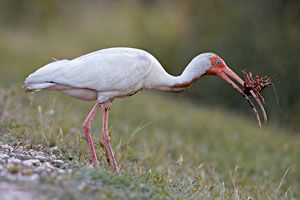
© Joanne Kamo
Eudocimus albus
Family: (Threskiornithidae) Ibises and Spoonbills
Preferred Habitat: Marshes, mudflats and flooded fields.
Seasonal Occurrence: Very common spring through fall. Less common in winter.
Profile by Glenn Olsen: I like the White Ibis because it's an odd-looking bird. In breeding season, the White Ibis has bright white feathers and crimson-red facial skin, bill, and legs. Its colorfulness and its long, de-curved (or downward-curving) bill give it a strange appearance as it wades in the shallow waters of marshes, ditches, and bayous in search of marine worms, snails, young crabs, crawfish, and other tasty morsels. You can find these birds year-round in freshwater and saltwater marshes, such as at Anahuac National Wildlife Refuge, Brazos Bend State Park, Addick's Reservoir, or at any of the bay marshes along the coast. The adult is all white, with black-tipped wings. Immature birds are mottled white and brown, and otherwise resemble the adult birds. In flight, the way to distinguish a White Ibis is to look for its down-curving bill, long neck, narrow body, and legs that extend beyond its tail. You will most often see White Ibis flying in flocks numbering from 5 to 25; their flap, flap, flap, glide flight pattern will help you identify them.
Whereas most species of birds use only one habitat for breeding, the White Ibis is unique in that it requires two habitats: brackish marshes and freshwater marshes. Adult birds feed in brackish water marshes and along the shoreline of bays, looking for young crab, small mollusks, and other aquatic food. White Ibis chicks are unable to digest salts found in saltwater food organisms, so its parents must hunt for crawfish in freshwater marshes such as those found at Brazos Bend State Park and Addick's Reservoir, as well as in ditches and bayous around Houston. Every time a bayou is cemented or a development supplants seasonal wetlands in or near Houston, the numbers of White Ibis diminish. The White Ibis is a beautiful bird worth preserving, and provides yet one more important reason for us to speak up for protecting their habitat when we see it being threatened in our neighborhoods.
Notes by Vicki Stittleburg: Easy to recognize, White Ibis stand 2 feet tall with pure white plumage and have a long, downcurved, red bill with a black tip. The face and legs are red. Black wing tips are visible in flight. Juvenile White Ibis are mottled white and brown, have an orange face and bill, dull orange legs and gradually transition to adult plumage.
White Ibis occur year round in our area but are most common spring through fall. They can be found in salt, brackish, and fresh marshes, estuaries, mangroves and swamps. White Ibis forage by wading in shallow water, sweeping their bill from side to side and probing for crayfish, crabs, snails, marine worms, and small fish. They also forage on land for insects in fields of short grass.
White Ibis breed in our area and are unique in that they require 2 habitats: brackish marshes to find food for themselves and freshwater marshes to locate food for their salt-sensitive young.
Good places to observe these beautiful wading birds include: Anahuac National Wildlife Refuge, Brazos Bend State Park, Addicks Reservoir, Galveston Island State Park or at any of the bay marshes along the coast.

© Greg Lavaty
Profile by Rachel Myers: The White Ibis is an easy to recognize resident on the upper Texas coast. They are often found in groups in wetlands and estuaries across the southeastern United States. White Ibises occur year-round in our area and will breed in our area, but they are most common spring through fall. Standing at about two feet tall, the White Ibis has long legs and a curved bill. Adults have white bodies with black wingtips and a bright red face, bill, and legs. Juveniles are mottled white and brown and have a duller face, bill, and legs. Both adults and juveniles have bright blue eyes. Their call is a nasal honk given in flight or while foraging.
White Ibises will thrive in many types of salt, brackish, and freshwater wetlands including swamps, estuaries, marshes, and mangroves. They will also forage on wet lawns, fields, and in parks. During the breeding season, White Ibis are unique in that they require two types of habitats: brackish marshes to find food for themselves and freshwater marshes to find food for their young, which are unable to digest salts found in saltwater organisms. White Ibises forage for insects and crustaceans, such as crayfish, earthworms, marine worms, and crabs. They sweep their bills side to side and probe for prey. They will also eat frogs, lizards, snails, and newts.
White Ibises are social birds; they forage in groups, fly in groups, and nest in colonies. Males will gather in large groups at the colony before breeding to attract a female. They perform several displays that involve head shaking, preening, bathing, group flights, and bill popping. Males and females typically form monogamous pairs, but males often mate with more than one female. Males will defend their female and nest from rival males during breeding season.
Within the colony, female White Ibises choose a nesting site. The male will then gather sticks for the nest and give them to the female, where she will then construct the nest in the fork of a dead tree. It takes about a week to build a nest, which is continuously maintained throughout the nesting season. Both the male and female will incubate the eggs and care for the nestlings. When baby Ibises hatch, however, their bills are straight and do not start to curve until they are about 14 days old. The parents will feed the nestlings until they can forage by themselves. Flying in a flock also takes some practice, as juveniles don’t fully learn the technique until they are about two months old.
The White Ibis is a permanent resident to the upper Texas coast, across the southeastern United States and all of Florida. They are also permanent residents to the coasts of Central America, northern South America, and throughout the Caribbean. Some are medium distance migrants and will migrate to the Southeastern United States coasts from inland areas. Some populations primarily winter in parts of Central America and Baja California. They can be found in the Smith Oaks, Horseshoe Marsh, and Dos Vacas Muertas Houston Audubon sanctuaries. Other good places to observe these birds include Anahuac National Wildlife Refuge, Brazos Bend State Park, Galveston Island State Park, or at any of the marshes along the coast.
-
Cornell Lab of Ornithology
-
Bird Guide
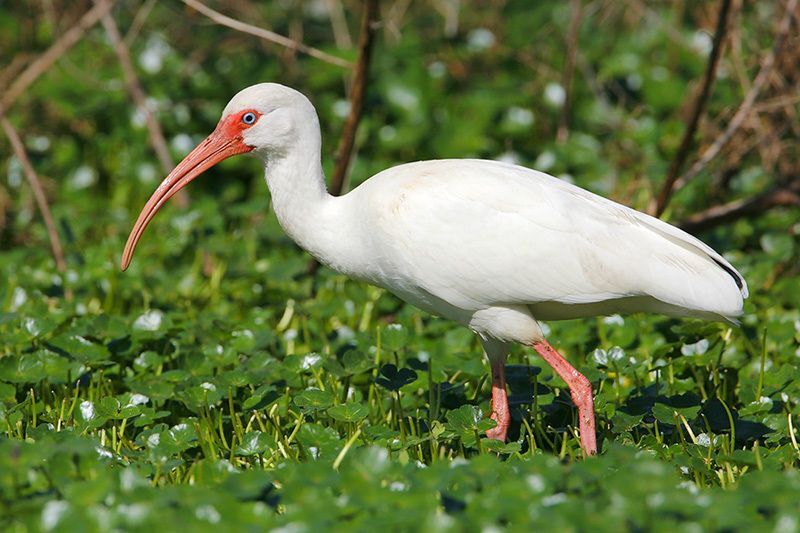
© Greg Lavaty, www.texastargetbirds.com
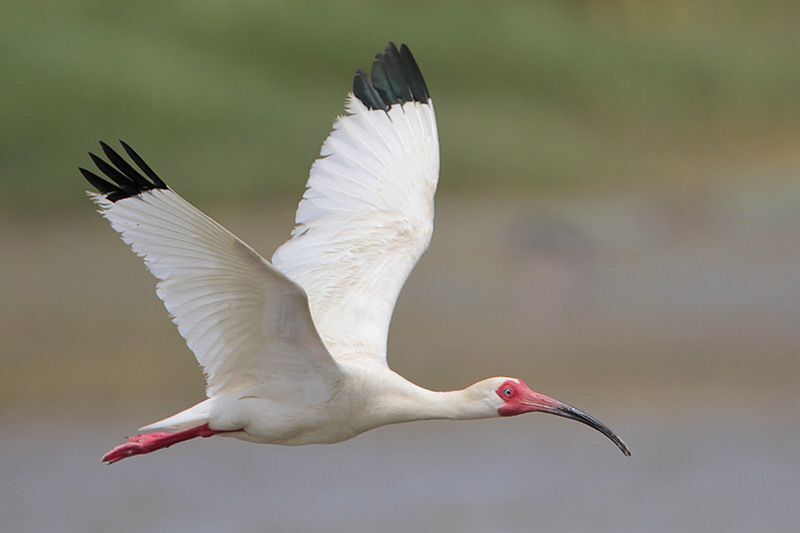
© Greg Lavaty, www.texastargetbirds.com
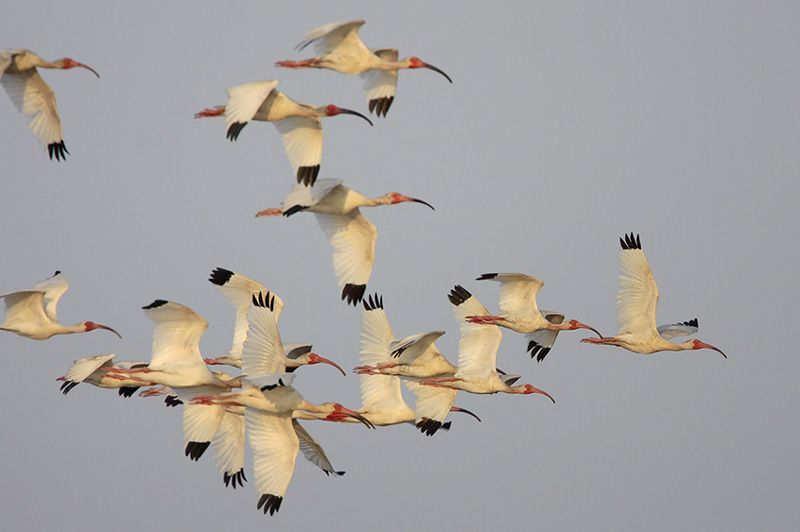
© Greg Lavaty, www.texastargetbirds.com
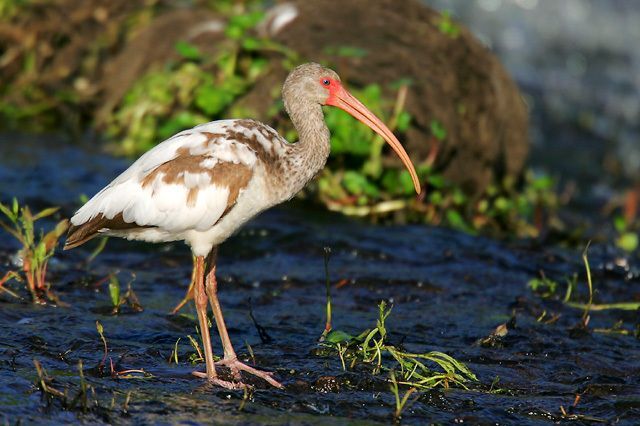
© Greg Lavaty, www.texastargetbirds.com




















